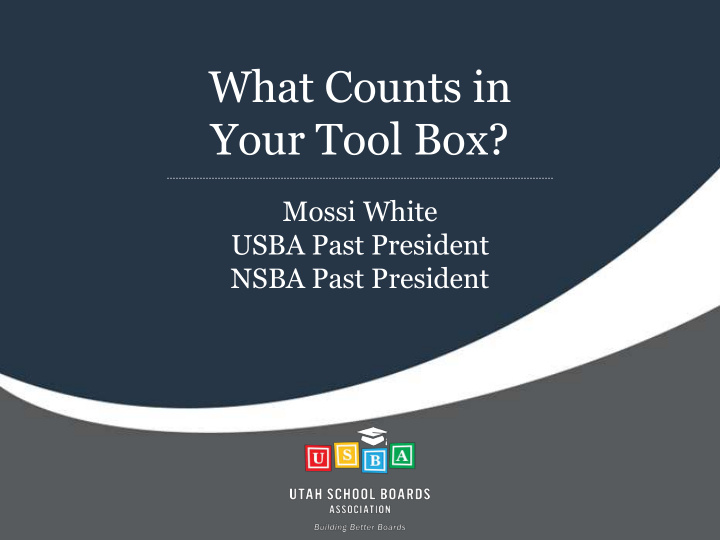



What Counts in Your Tool Box? Mossi White USBA Past President NSBA Past President
THE KEY WORK OF SCHOOL BOARDS IS TO INCREASE STUDENT ACHIEVEMENT
THE KEY WORK OF SCHOOL BOARDS • Climate • Vision • Collaboration • Standards • Continual • Assessment Improvement • Accountability • Alignment
COLLABORATION Improving student achievement through community engagement
WHAT COUNTS Community conversations
THE PROCEDURE • Set a date for the “What Counts” meeting • Each board member recommends 15-20 individuals to be invited. Ideal size of the group is 80-100 participants. They should include representatives from the entire community
THE PROCEDURE • RSVP Invitations are sent and followed up with personal contact • Choose a group facilitator who is not employed by the District. This person needs to be a strong communicator, strong advocate for public education, and have good presentation and facilitation skills
ROOM SET UP • Computer/projector • Markers /screen • Masking tape • Name badges • Sheets of eight • Round tables to seat marker dots for each eight participant • Large chart paper tablet with easel
THE MEETING • Eight people at each round table • Each table includes a facilitator chosen by the Board from the invitee group • Each table includes a recorder selected from the Board or staff. They do not participate in any discussion • A brief training session is held with facilitators and recorders 30 minutes before the meeting begins
DURING THE MEETING • Have an informal • Keep the discussion on “kitchen table” track conversation • Focus on constructive • Make sure everyone ideas understands there are • Have fun! no “right” answers • It’s okay to disagree (not disagreeably)
QUESTION #1 “What do you value about your local public schools?” • In your group, discuss what you value about the public schools in your District • Brainstorm a list that the recorder writes on chart paper • Come to agreement on your top six items • Post your chart paper on designated wall
GALLERY WALK • Pick a partner – not from your table • “Talk” a walk around the chart gallery • Discuss with your partner similarities and differences in the charts • What did you learn from the charts?
QUESTION #2 “What are the characteristics of a quality public school?” • Brainstorm a list that the recorder writes on chart paper • Come to agreement on your top eight items • Post your chart on wall
IDENTIFYING PRIORITIES • Pick a partner – not from your table • Take your “dots” with you as you “gallery walk” • Review each of the charts • Individually, use your dots to indicate your top/priority characteristics of a quality school • Return to original table
IDENTIFYING PRIORITIES • The characteristics will be prioritized by the number of “dots” they receive • The top eight characteristics will be listed on the computer by the group facilitator. Make sure all participants see the results
USES OF THE INFORMATION • Basis for District goal setting • Invite people to participate in ongoing task forces on • Tie into strategic plans specific topics • Foundation for budgeting • Conduct follow-up forums to priorities align strategies with system • Evaluation of District priorities programs, goals, etc… • Publicize the results in Board meetings, newspapers, and other organizations’ meetings
WHAT COUNTS Do not ask for community input if you do not intend to use the information
Recommend
More recommend